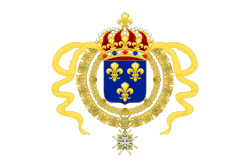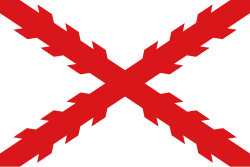Louisiana (Nya Frankrike)
| Louisiana | ||||
| Louisiane française (Franska) | ||||
| ||||
Flagga | ||||
| Nordamerika, cirka 1750 | ||||
| Huvudstad | Mobile (1702–1720) Biloxi (1720–1723) New Orleans (after 1723) | |||
| Språk | Franska | |||
| Religion | Katolsk kristendom | |||
| Bildades | 1682 | |||
| Upphörde | 10 mars 1804 | |||
| – uppgick i | ||||
Louisiana (franska: La Louisiane; eller La Louisiane française) eller Franska Louisiana var ett administrativt distrikt i Nya Frankrike. Det var under fransk kontroll åren 1682–1762 och 1802–1804[1], och uppkallad efter kung Ludvig XIV av Frankrike, av franske upptäcktsresanden René Robert Cavelier de La Salle. Området täckte ursprungligen stora delar av Mississippifloden och sträckte sig från Stora sjöarna till Mexikanska golfen och från Appalacherna till Klippiga bergen. Louisiana var indelat i två regioner, Övre Louisiana (franska: Haute-Louisiane), som började norr om Arkansasfloden, och Nedre Louisiana (franska: Basse-Louisiane). Den moderna amerikanska delstaten Louisiana namngavs efter regionen, fastän den bara utgör en liten del av det gamla franska området.
Källor
- Den här artikeln är helt eller delvis baserad på material från engelskspråkiga Wikipedia, 18 maj 2013.
Fotnoter
- ^ ”Louisiana” (på engelska). World Statesmen. http://www.worldstatesmen.org/US_states_L-M.html#Louisiana. Läst 8 november 2015.
Media som används på denna webbplats
Författare/Upphovsman: Sodacan, Licens: CC BY-SA 3.0
Royal Standard of King Louis XIV
British Red Ensign (1707–1800)
Författare/Upphovsman: Ningyou., Licens: CC BY-SA 3.0
Flag with the cross of Burgundy (saltire). Also named Cross of Burgundy flag. It was used in the Catholic Monarchy and in its viceroyalties such as New Spain and Peru. It was also used by Spain as a military or king's prosonal flag. Used by the Carlist movement.
Författare/Upphovsman: Pinpin, Licens: CC BY-SA 3.0
Map of New France about 1750 using modern political boundaries
Digital reproduction of the Star Spangled Banner Flag, the 15-star and 15-stripe U.S. garrison flag which flew over Fort McHenry following the Battle of Baltimore in the War of 1812. Seeing the flag during the battle, and again the following morning, inspired Francis Scott Key's song The Star-Spangled Banner, now the U.S. national anthem. During the battle a smaller "storm flag" was flown; it was replaced by this larger flag early the next morning, which is the flag Key saw then. This larger flag is now displayed at the National Museum of American History in Washington, D.C. For several decades it remained in the family of Fort McHenry's commanding officer, before being given to the Smithsonian in 1912. The family cut pieces out of the flag from time to time as gifts.
The original flag was 42 feet long and 30 feet high, with each stripe being about two feet, and the stars being about two feet in diameter. It was made by Mary Young Pickersgill and her assistants. More info on the original dimensions here. The stars seem to mostly point to the side, except for one (the bottom right) which points down. One star has been cut out of the actual flag, so I'm guessing that originally pointed to the side as well (Fort McHenry flies a flag (File:Ft mchenry 15starflag.jpg) with a similar star pattern, but it looks like they are all to the side, and the other dimensions look similar to a modern flag). I guesstimated other dimensions and star positions based on File:Star-Spangled-Banner-1908-1919.jpg; the union (blue area) looks to be about 19 feet wide. The star rows look to be evenly distributed; i.e. the distance between the top/bottom edges and the center of a star row looks to be about the same as the distance between two (centers of) rows. Not so left-to-right; they are pretty close to the right edge and even closer to the hoist side. Also available here, page 12.






